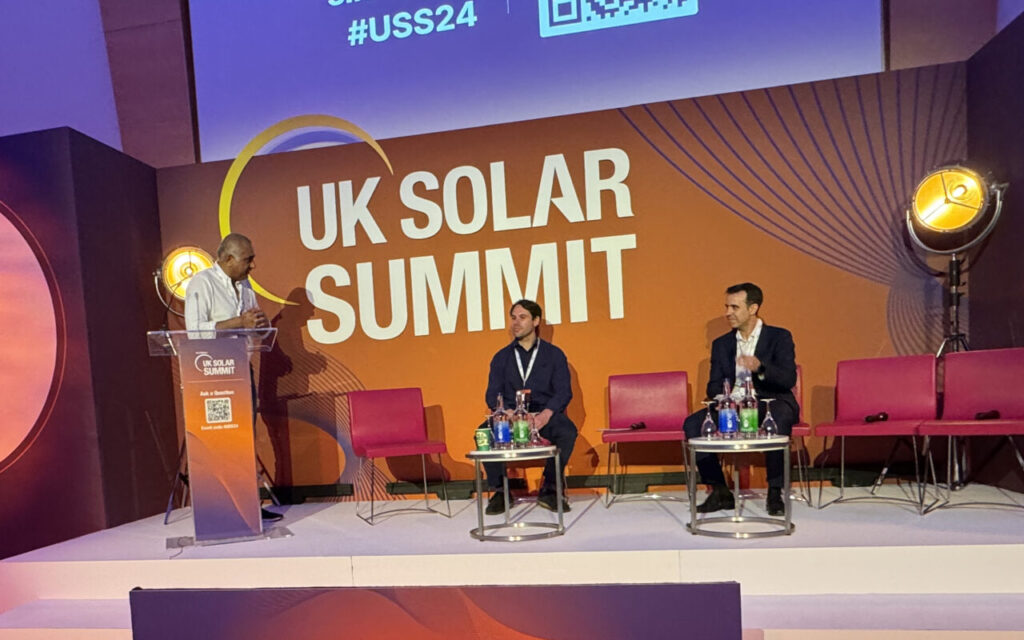
In a world of escalating capital costs and the corresponding need to maximise project returns, technology is becoming increasingly important. AI and machine learning allow the vast quantities of data that solar farms produce to be digested, analysed and built into powerful strategic insight.
That was the thrust of the session titled How is technology driving UK solar forward? on day two of UK Solar Summit, where moderator Abid Kazim, investor founder of Lumina Renewables, opened the session by stating: “The cost of capital has become a problem. We can’t throw money at solar plants anymore, we have to make them work better.”
With that in mind, the industry is turning to technology to deliver new approaches to increased solar efficiency, which is altering the way we think about and measure success.
Less is more
The conventional approach to project design has been to orient solar modules to the south to maximise energy production. To produce more power and, therefore, a larger return, you simply add modules. However, the rising cost of capital, both to finance additional modules and the land to site them, means this approach no longer creates the returns it once did.
Eric Montméan head of UK solar development at TotalEnergies, spoke of a French solar farm where the modules have been oriented west. This means, unlike south-facing PV, the modules capture more energy later in the afternoon, when market prices are higher, delivering higher ROI despite producing fewer overall watts. The result? A 16% increase in revenue by capturing more power at the end of the day. TotalEnergies is currently testing this methodology in the UK, and the signs are promising. Skewing generation can generate more revenue per watt, even if you’re generating fewer watts.
Mitigating losses
Artificial intelligence, in general, and machine learning, in particular, can not only revolutionise the process of planning new projects and delivering increased returns for existing projects but can also be used to identify issues with existing installations.
Emilio Martinez, head of technical advisory and asset management UK at Vector Renewables extols the virtues of using artificial intelligence to pinpoint issues with existing projects.
“We had a client that invested in a brand new 50MW PV plant with state-of-the-art trackers. During the first and second years, production was around 6% below expectations. On such a large project, 6% has a massive impact on the project’s economics,” Martinez said.
“We used machine learning to replicate the real PV installation following mathematical modelling. We ran different models over a few months. You have 200 inverters, add in the trackers and the volume of data is massive. Our models predicted production with an accuracy of 0.4%.”
The EPC constructor stated there were no easily identifiable issues, and they were right, but the team’s modelling discovered that the trackers were operating 4% below specification. In addition, the modules themselves weren’t operating according to expected characteristics—they were 2% below the claimed output.
These figures can be attributed to temperature issues, where silicon performs less effectively at higher temperatures, but that wasn’t the issue. Lab testing discovered the modules weren’t operating at the quoted outputs according to the specifications. The manufacturer, though, didn’t accept the modules were defective.
While the insight didn’t result in financial compensation for the project owner, it did result in Vector’s client including clauses in future contracts for panel performance and tracker gain to mitigate against future issues.
The new tech frontier
Machine learning allows us to measure everything and digest that information at scale and at speed. Tens of thousands, hundreds of thousands, or millions of data points can be processed in the blink of an eye, identifying issues near-instantaneously. The sheer volume of data that can be ingested and analysed is staggering—vastly more than can be achieved manually.
Using this technology to assess and reassess projects means that efficiencies can be found throughout the planning, construction and operation processes. That means costs can be tightly controlled, as can revenue, which may mean the difference between a project being green-lit or cancelled.
Closing the session, Kazim summed up this new technological frontier: “The biggest challenge we’re facing now, and we’re going to be facing it for the foreseeable future, is that Europe is calling in capital to build new energy plants. That pulls upon every penny we have available to us, and if you can’t make the money, then you can’t build more plants.
“So we need to find creative ways of maximising value. Technology is changing the conversation.”

